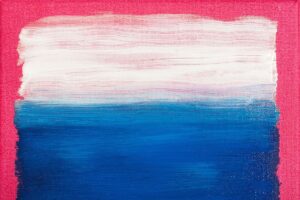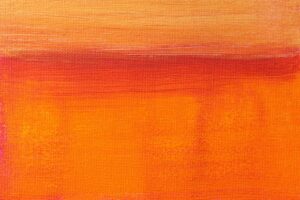Color Field Painting is a style of abstract art that emerged in the mid-20th century, characterized by large fields of flat, solid color spread across or within the canvas.
It’s a movement that delves into the purity of colors, often evoking a contemplative or emotional response from viewers.
We’ll explore the origins, key artists, and the unique techniques that define this captivating art form.
Stick with us to uncover why Color Field Painting holds a significant place in the history of modern art.
Origins Of Color Field Painting
Color Field Painting marks an evolution in the annals of abstract art, with its roots deeply anchored in the early works of abstract expressionism.
We see this in the pioneering pieces of Mark Rothko, Barnett Newman, and Clyfford Still, who broke away from the gestural brush-strokes of their predecessors to settle into the tranquility of pure color.
It wasn’t long before these visionaries crystallized what would later be identified as the hallmark of Color Field Painting – vast expanses of color that disappear beyond the canvas bounds.
As purveyors of art history, we observe that the progression towards this style was less about rebellion and more a natural drift towards simplification and purity of form.
- Historical Milestones –.
- The emergence of Color Field Painting in the 1940s and 1950s,
- The pivotal exhibitions that showcased works of key figures in this movement,
- Progressive art galleries and collectors that embraced and propelled the style.
Artists like Helen Frankenthaler amplified the technique with her introduction of the soak-stain method.
By diluting her paint and applying it onto unprimed canvas, she allowed these hues to seep into the fabric, merging paint and canvas into a single, harmonious entity.
This innovation added a new dimension to the genre, providing a bridge between painting and the viewer’s space.
The widespread recognition of Color Field Painting and its influence on the modern art movement was bolstered by critics like Clement Greenberg.

Through his writings and exhibitions, we trace the public’s growing appreciation for this form – an appreciation that linked visual experience with internal, emotional resonance.
Embarking on a journey through the evolution of Color Field Painting, we jump into the nuanced shifts that propelled this movement to prominence.

From the galleries of New York to the broad spectrum of artists who adopted and adapted its philosophy, the saga of Color Field Painting is rich with innovation and enduring visual impact.
Key Artists Of Color Field Painting
When exploring the titans of Color Field Painting, certain names stand out for their groundbreaking work and enduring influence.
These artists defied convention and created a legacy that reshapes our understanding of color and abstraction.
Mark Rothko – Embracing The Sublime
Mark Rothko’s large canvases are renowned for their bold blocks of color and a sense of spirituality.
His works, such as Untitled (Black on Grey), beckon viewers into a contemplative space, where hues resonate with deep emotion and existential questions.
Barnett Newman – The Zip As A Signature
Barnett Newman introduced a distinctive element to Color Field Painting with his ‘zips’, vertical lines that dissect the canvas.
Vir Heroicus Sublimis, one of his most commanding paintings, exemplifies how these zips create spatial complexity and invite personalized interpretations.
Clyfford Still – Dynamic Brushwork
Clyfford Still’s contributions to the movement are marked by jagged forms and a rich painterly texture.
His preference for palette knives over brushes brought a dynamic physicality to works like PH-247.
These pieces are characterized by their energetic application of paint and raw emotional intensity.
Helen Frankenthaler – The Soak-stain Technique Pioneer
Helen Frankenthaler revolutionized the method by which paint could be applied to canvas.
By introducing the soak-stain technique, she enabled pigments to seep into the fabric, as seen in Mountains and Sea, creating delicate veils of color that appear to float within the canvas.
Our continued exploration of Color Field Painting’s key figures reveals varied approaches to the use of color – from Rothko’s enveloping rectangles to Newman’s zips, and Frankenthaler’s pioneering staining technique.
These artists’ innovations keep informing and inspiring new generations in the realms of visual arts and filmmaking, underscoring the movement’s enduring relevance.
Techniques Of Color Field Painting
Color Field Painting is synonymous with simplicity and purity in the visual arts.
At its core, this movement embraced large expanses of color that could envelop the viewer in a sensory experience unmatched by more figurative art forms.
Here, we’ll jump into the methods that define this genre’s unique approach to artmaking.
Artists in the Color Field movement often applied paint in large, flat areas, aiming to create a sense of infinity within their canvases.
They preferred to let the inherent qualities of the color speak for themselves, without the interruption of texture or brushstrokes.
Helen Frankenthaler’s soaking technique, for example, involved pouring thinned paint onto unprimed canvas, allowing it to soak into the fabric and create subtle, organic edges.
- Characteristics of the technique – – Large, flat planes of color – Minimal brushwork – Color as the primary subject – Emphasis on emotional content through color.
This technique wasn’t just a method; it was philosophical, provoking contemplation and a deeper emotional response from the audience.
Mark Rothko famously created works with a luminous quality, placing complementary colors in close proximity to create a gentle vibration that resonated on both a visual and emotional level.
Canvases in Color Field Painting often occupied a large scale – a conscious choice that made the color fields envelop the viewer’s field of vision.
Barnett Newman employed vertical lines, or zips, that dissected these color planes, directing the viewer’s eye and introducing a spatial dynamism within the simplicity of the composition.
This interplay between color and scale allowed viewers of the artwork a moment of pause and reflection, a sensory experience often mirrored in the cinematic world where colors can set the tone of an entire scene.
By reducing the elements to pure color and scale, Color Field painters set the stage for an immersive experience.
The lack of complex narrative and figurative distractions guided the audience to a contemplation of the internal and the subliminal.
As we further explore this art form, we’re reminded of its lasting impact on visual storytelling in film.
The simplicity of these techniques belies the depth of emotion they can evoke, an aspect that continues to resonate in various creative domains, including the art of filmmaking.
Impact And Significance Of Color Field Painting
The advent of Color Field Painting marked a pivotal turn in the course of modern art.

Artists of this movement brought forth a new understanding of color’s role – not merely as a component but as the soul of the canvas.
Their legacy has influenced countless artists and continues to inspire across various mediums, particularly in film and digital art.
We can’t talk about the impact of this movement without acknowledging its effect on the viewer’s psychology.
These vast, unbroken expanses of color create an immersive experience, making us part of the artwork itself.
Rothko Chapel stands testament to the emotive power of Color Field works.
- Interior design and architecture have borrowed from Color Field Painting’s emphasis on expansive single hues, using them to create mood and add depth to physical spaces.
- Filmmaking techniques, such as the use of color to convey emotion or establish atmosphere, echo the visual strategies initiated by Color Field artists.
- Digital marketing leverages color psychology, rooted in the Color Field principles, to enhance user engagement and influence consumer behavior.
As we jump deeper into the significance of Color Field Painting, it’s impossible to overlook its challenge to traditional narratives in art.
This movement encouraged a departure from realism and narrative, demanding the viewer’s emotional and psychological involvement.
It wasn’t just visual arts that felt the ripple – disciplines from music to fashion absorbed aspects of its philosophical underpinnings.
Through our lenses, we’ve seen countless films that owe a subtle nod to the Color Field movement.
Directors use color to create a visceral response similar to the intentions of artists like Newman and Rothko.
From serene to horrifying, these color palettes are manipulated to pull us into the story, much like a Color Field painting envelops the viewer in mood.
What Is Color Field Painting – Wrap Up
We’ve traversed the vibrant landscape of Color Field Painting, appreciating its profound impact on the art world and beyond.
It’s clear that this movement’s influence stretches across various creative domains, shaping our perception of color and its emotive power.
We recognize its transformative effect on interior design, architecture, and the digital realm, ensuring that Color Field Painting’s legacy endures.
By demanding our emotional engagement, these artists have forever altered our visual and psychological experiences, embedding their revolutionary concepts into the fabric of modern aesthetics.
Frequently Asked Questions
What Is Color Field Painting?
Color Field Painting is an art movement that emerged in the mid-20th century, focusing on large fields of flat, solid color spread across or stained into the canvas to create an unbroken surface and a flat picture plane.
How Did Color Field Painting Impact The Understanding Of Color In Art?
Color Field Painting brought a new understanding of color as the primary conveyer of meaning and emotion in a piece of art, highlighting its role as the essence or soul of the canvas.
In Which Ways Has Color Field Painting Influenced Other Mediums?
Color Field Painting has influenced various mediums such as film, digital art, interior design, architecture, and even digital marketing, by inspiring the use of color to evoke emotional responses.
How Did Color Field Painting Challenge Traditional Narratives In Art?
The movement challenged traditional narratives by focusing on the emotional and psychological impact of color and composition, rather than figurative or representational imagery, demanding a new kind of viewer engagement.
Can You See The Influence Of Color Field Painting In Modern Films?
Yes, the influence of Color Field Painting is evident in modern filmmaking, where directors use color to create visceral responses and immerse the viewer in a specific mood, taking cues from the movement’s legacy.


